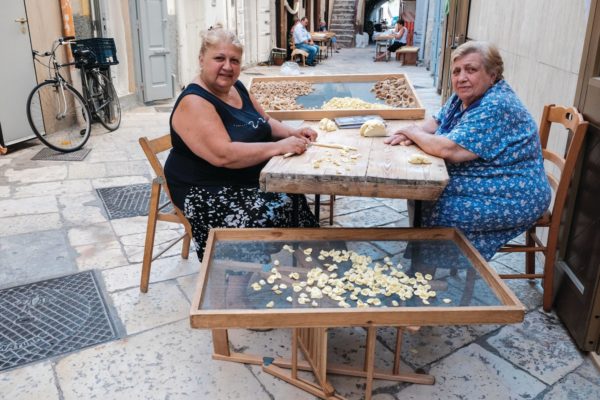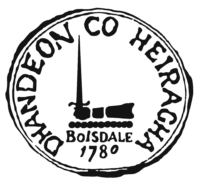Puglia: A Valley By The Sea
Bill Knott encounters the unique beauty of Italy's east coast by day and feasts on its natural bounty by night to prepare for the Boisdale Puglia Expedition, 8-14 October 2022, which he will co-host with Boisdale founder Ranald Macdonald
By Bill Knot
February 14 2023
As the heel of Italy, Puglia has, inevitably, been booted around over the centuries. Greeks, Saracens, Normans, Turks, Spaniards… all have been here as colonists, conquerors or invaders, and all have left their footprints. But there is a rustic serenity here too –
there are 15 times more olive trees than people, for example. Agriculture is huge in Puglia: in the north, durum wheat fields produce the vast majority of flour used to make Italy’s pasta, and those trees – many of them ancient, huge, gnarled and twisted – produce at least 40% of the country’s olive oil.

The hot, sunny climate and fertile soils encourage Puglia’s farmers to grow almost anything. Arrive in spring, and the markets are teeming with fresh peas and broad beans, artichokes, cherries, and the first of the season’s tomatoes. Summer will see courgettes, aubergines, peaches, melons, and figs, followed by autumnal offerings of mushrooms, chestnuts, and grapes. Tomatoes are semi dried for winter, when they might partner cime di rapa, Puglia’s famous mustard greens, in a dish of orecchiette, ear-shaped pasta.

Each town has its own cuisine and its own character, a reflection of both history and geography, and it is a joy to discover the differences. Most visitors arrive by air to Brindisi or Bari – the biggest city in Puglia. While the “new” part of the city, built in 1813 by the King of Naples, is pleasant enough, it is Bari’s atmospheric Old Town that grabs a visitor’s attention, from the 12thcentury altar and throne of the Basilica di San Nicola to the archaeological museum in the monastery of Santa Scolastica and the 8th-century icon of the Madonna in the Cattedrale di San Sabino.
Or just stroll through the lanes and watch the ladies making pasta, expertly flicking the dough into shape on blond wooden boards while gossiping with each other and watching TV. Then sample the distinctive cucina barese at one of the Old Town’s many great restaurants, or just snack on the local foccaccia, made with a potato-enriched dough and studded with olives and sweet little tomatoes.

An hour’s drive south-east, the “white city” of Ostuni is the perfect base from which to explore Puglia. It has an ancient history and was rebuilt by the Greeks 2,000 years ago: They called it astu néon – “new town” – from which the modern town takes its name. Today, its labyrinth of sun bleached alleyways that snake up to the main square attract thousands of tourists in the height of summer, while the surrounding countryside features many masserie – substantial estate houses – among the vineyards and olive groves. The Adriatic coast, a few miles away, has many miles of pristine beaches, nature reserves and fishing villages.
Another hour’s drive south-east takes you to the beautiful town of Lecce, theatrically Baroque in style, a legacy of the Spanish influence on this corner of Italy. The Basilica di Santa Croce is perhaps the finest example: 150 years in the making, its crowning glory is the upper façade, flamboyantly carved from local sandstone, with an ornate rose window at its centre.
Then to Otranto, a relaxed port town – except in high summer, when its nightlife is at its liveliest. Built on the site of the ancient Greek city of Hydrus, Otranto suffered a particularly grisly invasion by the Ottomans in 1480, during which more than half of the population (and all the men) perished. Today, it is a lovely place for a wander around its kasbah-like heart, or to visit its handsome medieval cathedral, which houses relics and bones from the 813 Martyrs of Otranto who refused to convert to Islam following the invasion.
Despite the many foreign influences on the region’s architecture, there is one style of building that is distinctively, defiantly Puglian: trulli – the cylindrical, conical-roofed, dry-stone huts that are mostly found around the towns that overlook the Itria Valley, north-west of Ostuni, including Martina Franca, Locorotondo and, most prolifically, Alberobello. Many of the conical roofs also feature whitewashed symbols, mostly religious in nature. Nobody is quite sure how the trullo originated. One theory is that property was highly taxed by the local feudal lord, so a dry-stone dwelling could easily be dismantled when the inspector came calling. More probable is that they were simply useful shelters for peasants, shepherds, farmers, and their animals. Built in the same way and from the same materials as the walls that divided fields and pastures, their thick walls would insulate against the extreme weather of both winter and summer. Many have now been converted into holiday homes or B&Bs.

For me, the greatest joy to be found in Puglia, however, lies not its architecture, but its soil. It is home to vines and fruit orchards and ancient olive trees – Masseria Brancati, outside Ostuni, has an enormous one known as The Elephant, thought to be 3,000 years old. It is not Tuscany, although it produces far more oil and wine, and doesn’t try to be. Take a table, pour a glass, soak up the sun, and marvel at a slow and traditional pace of life that has withstood the
pressures of the modern world.

There are fancy hotels in Puglia now. There are even a dozen or so Michelin-starred restaurants, and some of them are very good. Billionaires on yachts occasionally drop anchor in Puglia’s harbours. But there are fewer richer experiences in life than sitting under the dappled sunlight of an old olive tree, languidly dunking crusty bread into peppery olive oil, scooping up mouthfuls of fave e cicoria, sipping a fruity, slightly chilled red, and reflecting that this is exactly what the Greeks and Romans once did here, and how the best things in life never change.
WHAT'S ON
Discover what's going on across our famous venues
NYE with FiL Straughan & Mi-Soul DJ's
Canary Wharf
31 December 2025
Welcome 2026 with FiL Straughan and Mi-Soul DJs at Boisdale of Canary Wharf. A night of refined dining, soulful performance and classic R&B, followed by a DJ after-party that runs until 3am. The capital’s definitive setting for a full New Year’s Eve experience.
The Wonder of Stevie
Canary Wharf
2 January 2026
A vibrant celebration of Stevie Wonder’s lifetime of genius, led by mesmeric vocalist Noel McCalla and award-winning saxophonist Derek Nash, performing the landmark songs that shaped soul, funk and Motown across generations.
Cuban All Stars present the Buena Vista
Canary Wharf
7 January 2026
London’s leading Latin musicians, led by Sambroso Noda, bring the spirit of Havana to life with a powerful celebration of Buena Vista Social Club and Cuba’s greatest musical legends. Expect irresistible rhythms, rich percussion and a night of authentic Cuban soul.
DJ Luck & MC Neat
The Hine Bar
29 January 2026
DJ Luck & MC Neat bring the sound of UK Garage to Boisdale of Canary Wharf, with rolling 2-step beats, soulful hooks and lyrical flow that shaped the scene. Hosted by resident DJ Lola So, the night celebrates the groove and spirit of London’s golden era of club culture.
Artful Dodger
The Hine Bar
26 February 2026
The pioneers of UK Garage, Artful Dodger, burst onto the scene in the late ’90s with hits like “Re-Rewind” and “Movin’ Too Fast”. Hosted by Lola So, they return to bring the dancefloor alive with a night of classic House and Garage anthems at Boisdale of Canary Wharf.
Boney M
Canary Wharf
6 March 2026
Founding member Maizie Williams brings the iconic sound of Boney M to Boisdale with a night of pure disco nostalgia, featuring classics like “Rivers of Babylon”, “Daddy Cool” and “Rasputin”. A rare chance to experience one of pop’s most enduring acts up close.
